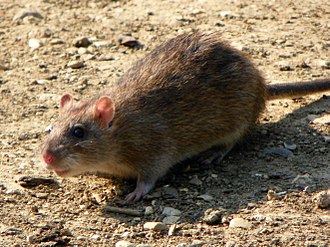Brown rat

The brown rat (Rattus norvegicus), also known as the common rat, street rat, sewer rat, wharf rat, Hanover rat, Norway rat, Norwegian rat and Parisian rat, is a widespread species of common rat. One of the largest muroids, it is a brown or grey rodent with a head and body length of up to 28 cm (11 in) long, and a tail slightly shorter than that. It weighs between 140 and 500 g (5 and 17+3⁄4 oz). Thought to have originated in northern China, this rodent has now spread to all continents except Antarctica, and is the dominant rat in Europe and much of North America. With rare exceptions, the brown rat lives wherever humans live, particularly in urban areas.
Selective breeding of the brown rat has produced the fancy rat (rats kept as pets), as well as the laboratory rat (rats used as model organisms in biological research). Both fancy rats and laboratory rats are of the domesticated subspecies Rattus norvegicus domestica.
The brown rat was originally called the “Hanover rat” by people wishing to link problems in 18th-century England with the House of Hanover.[2] It is not known for certain why the brown rat is named Rattus norvegicus (Norwegian rat), as it did not originate from Norway. However, the English naturalist John Berkenhout, author of the 1769 book Outlines of the Natural History of Great Britain, is most likely responsible for popularizing the misnomer. Berkenhout gave the brown rat the binomial name Rattus norvegicus, believing it had migrated to England from Norwegian ships in 1728.
By the early to middle part of the 19th century, British academics believed that the brown rat was not native to Norway, hypothesizing (incorrectly) that it may have come from Ireland, Gibraltar or across the English Channel with William the Conqueror.[3] As early as 1850, however, a new hypothesis of the rat’s origins was beginning to develop.[4] The British novelist Charles Dickens acknowledged this in his weekly journal, All the Year Round, writing:
It is frequently called, in books and otherwise, the ‘Norway rat’, and it is said to have been imported into this country in a ship-load of timber from Norway. Against this hypothesis stands the fact that when the brown rat had become common in this country, it was unknown in Norway, although there was a small animal like a rat, but really a lemming, which made its home there.[5]
Academics began to prefer this etymology of the brown rat towards the end of the 19th century, as seen in the 1895 text Natural History by American scholar Alfred Henry Miles:
The brown rat is the species common in England, and best known throughout the world. It is said to have travelled from Persia to England less than two hundred years ago and to have spread from thence to other countries visited by English ships.[6]
Though the assumptions surrounding this species’ origins were not yet the same as modern ones, by the 20th century, it was believed among naturalists that the brown rat did not originate in Norway, rather the species came from central Asia and (likely) China.[7]
